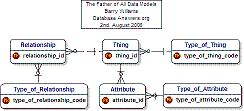 |
These are the Steps we followed in defining our Universal Data Model (UDM).
Step 1 : Getting Started
Recently (January, 2014) I started thinking about the nature of a UDM.
Then I realised that my starting-point would have to be my Canonical Data Model because I created it to be a transaction-level Generic Model.
Step 2 : What else do I need ?
My Canonical Data Model is Event-oriented so I wondered 'What do I need to include that is NOT an Event ?'
I decided that everything that people do is an Event.
At first it seemed I would have to include Activities as well as Events but I found that (In the UK) there is something called a Three-Day Event which is an
Equestrian competition, and, (of course) takes place over 3 days.
Therefore I decided I did not need an extra Entity called Activities.
So What I needed to include that is NOT an Event was the calculation of derived figures such as Financial Totals and data for Performance Reports.
This might lead to the design for a Data Mart, which is very useful for providing data for Reports and Business Intelligence.
After more reflection, I realised that thw Model has to include things that happen before or after Events.
In other words, those that are related to planning for Events or analysing Performance after EVents have taken place.
Then I realised that all the things that happen before or after Events are simply other Events.
Of course, we can identify different patterns in these Events so we can establish a Framework of Design Patterns.
© DataBase Answers Ltd. 2015
|

